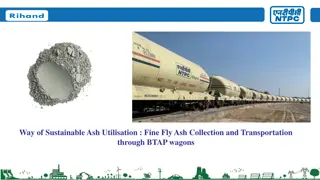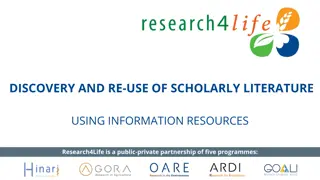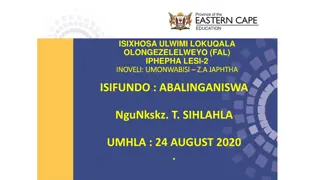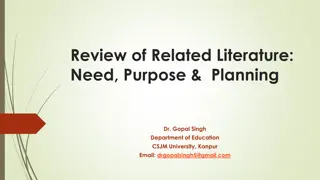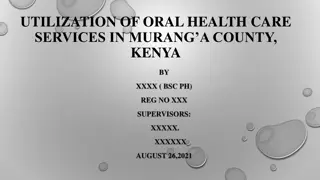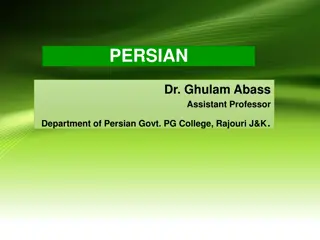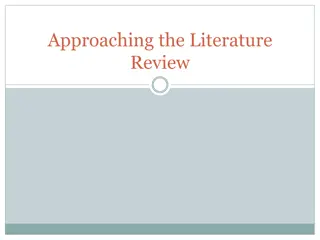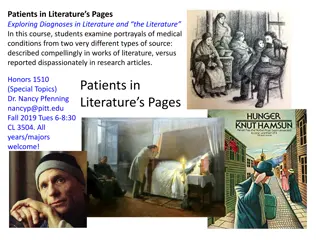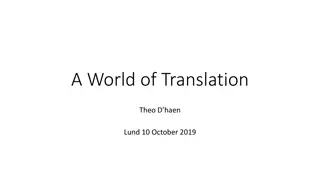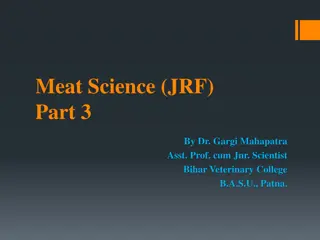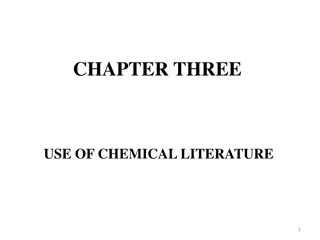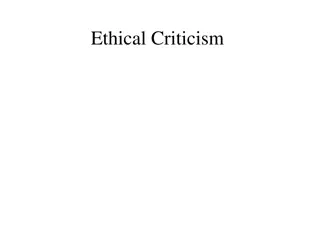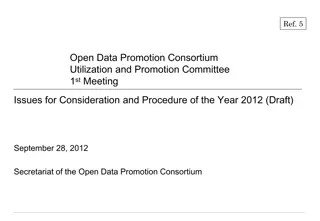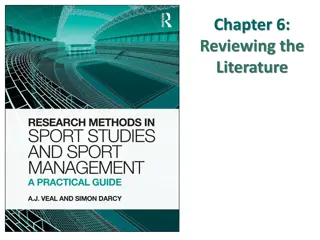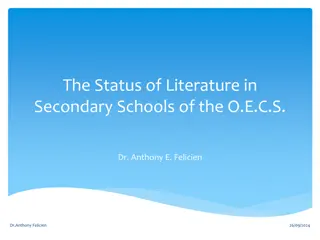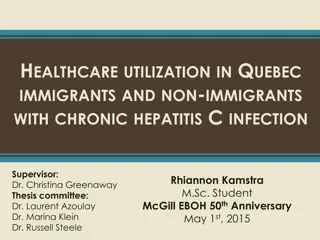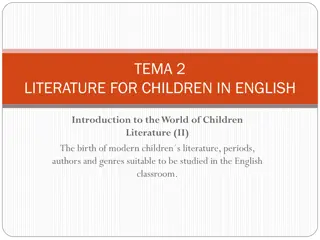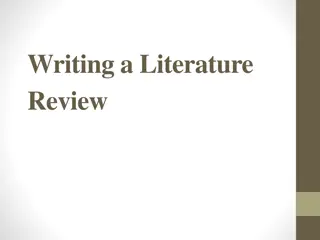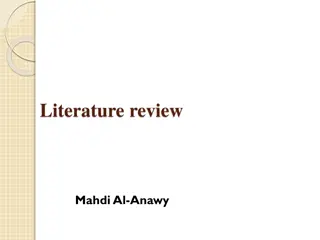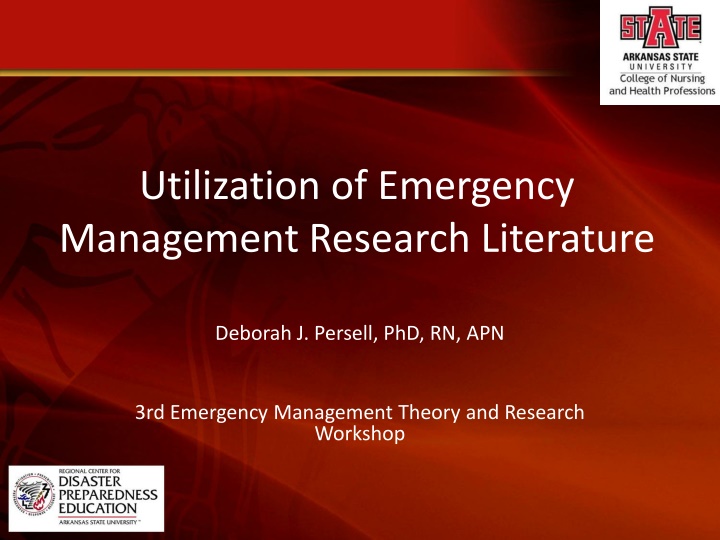
Enhancing Utilization of Emergency Management Research Literature
Urgent need for research literature in emergency management, highlighting a decline in library resource utilization and credibility awareness. The review of literature showcases the evolving landscape of accessing information, emphasizing the importance of communal aspects of libraries for students. Assessments reveal current patterns in student library utilization, indicating a gap in information access that requires interventions and programs to bridge. Course requirements focus on rubric-driven assignments and peer-reviewed research articles, with a call for disseminating evidence-based information to elevate the quality of work in the discipline.
Download Presentation

Please find below an Image/Link to download the presentation.
The content on the website is provided AS IS for your information and personal use only. It may not be sold, licensed, or shared on other websites without obtaining consent from the author. If you encounter any issues during the download, it is possible that the publisher has removed the file from their server.
You are allowed to download the files provided on this website for personal or commercial use, subject to the condition that they are used lawfully. All files are the property of their respective owners.
The content on the website is provided AS IS for your information and personal use only. It may not be sold, licensed, or shared on other websites without obtaining consent from the author.
E N D
Presentation Transcript
Utilization of Emergency Management Research Literature Deborah J. Persell, PhD, RN, APN 3rd Emergency Management Theory and Research Workshop
Background: Description of the Problem Urgent need for research literature Multiple web-based platforms Utilization of library resources declining Lack of credibility awareness
Review of Literature Traditional use of libraries doesn t meet student needs (Gardner & Eng, 2005; May & Swabey, 2015) Technology has changed how students access literature (Cha & Kim, 2015; Gardner & Eng, 2005; Gayton, 2008; May & Swabey, 2015; Saunders, 2015; Simmonds & Andaleeb, 2001) Students value communal aspects of libraries (Gayton, 2008) Familiarity with library and its resources increases student use (Soria, Fansen & Nackerud, 2013)
Assessment of Student Utilization of Library Use 15 Librarians, 18 support staff 1 librarian assigned to DPEM Purchased $66,000 in EM literature Journal use unable to track Book use not tracked by student major 82 checked out at least once 23 checked out more than twice 2 checked out more than 9 times
Web-based utilization Internet sites versus Databases Some credible Few research based Most biased Health Alert Networks News stories credible or not Reliance on personal experience Wikipedia
Course Requirements/Resources Rubric driven assignments Peer reviewed research articles required Application/critique of articles required Resident Librarian in course Faculty
Gap in Information Access Interventions and programs are necessary to bridge this gap and facilitate the dissemination of evidence-based information to elevate the quality of work and ultimately the discourse in the discipline.
Purpose Improve utilization of evidence-based literature in disaster preparedness and emergency management.
Aims Increase awareness, access, and utilization of evidence and web based databases. Develop tools and resources to facilitate awareness, access and utilization of scientific databases and journals. Increased knowledge regarding disaster preparedness and management.
Methods Soft systems framework Quasi-experimental design IRB approval Pre/Post Survey Convenience Sample Students Professionals
Soft Systems Methods Framework to understand the different perspectives of different stakeholders related to the problem under investigation. Facilitates the creation of solutions that action-based methods utilize to tackle real- world problems. Seven step process. (Por, 2008)
Is it assumed that you will read research literature as part of your education or employment?
Select the highest level of education you have completed or are currently enrolled in.
Are you allowed time in-class or on the job for reading research literature?
Which of the following best represents the agency you are associated with?
Please rate your familiarity with the terms listed below:
Do you regularly scan the tables of contents or abstracts of research articles?
Do you regularly read the full content of research-based articles?
If you do not regularly read research-based articles please tell us the reasons
Do you believe your past education has adequately prepared you to read and understand research-based literature?
If information was provided to help identify and examine research articles and scientific databases would you be interested?
How useful do you think information about using scientific databases and journals are for your education program or job?
If such information were made available to you, which format would you most prefer it to be?
Conclusions Utilization of research is an expectation in education and employment Time is the most provided reason for not reading research literature (38%). 63% are given time for this Only 32% read past the abstract
Conclusions continued We have not done a good enough job to demonstrate the relevance of research literature 12% don t have enough expertise to use research 8% don t consider research relevant 14% prefer opinion based articles 17% do not enjoy or are not interested in research Yet, 72% say their education sufficiently prepared them to read and understand research
Conclusions continued Approximately 25% are familiar or very familiar with search terms Interest in learning to search for, read and understand research is found 37% moderately interested 27% very interested 13% extremely interested They do not prefer librarian assistance to learn
Recommendations Focus groups with students and professionals Add course content on search words Include content on identifying credible scholarly literature Re-evaluate expenditures and types of library assets Revisit the resident librarian concept to design online communal library atmosphere include pushing literature Encourage librarian to complete Disaster Information Specialist
Disaster Information Management Research Center sis.nim.nih.gov/dimrc.html Disaster Types and Topics Emergency Response Tools Disaster Health Literature Disaster Information Specialist Librarians & Disasters NLM Projects & Research Search TOXINET Databases Training Courses & Resources
Limitations Students from one program Professionals from one current geographic location Online program prohibits most student s physical use of library Determination of utilization of library resources flawed
Selected References Cha, S. H., & Kim, T. W. (2015). What Matters for Students' Use of Physical Library Space? The Journal of Academic Librarianship,41(3), 274-279. doi:10.1016/j.acalib.2015.03.014 Gardner, S., & Eng, S. (2005). What Students Want: Generation Y and the Changing Function of the Academic Library. Portal: Libraries and the Academy,5(3), 405-420. doi:10.1353/pla.2005.0034 Gayton, J. T. (2008). Academic Libraries: Social or Communal? The Nature and Future of Academic Libraries. The Journal of Academic Librarianship,34(1), 60-66. doi:10.1016/j.acalib.2007.11.011 May, F., & Swabey, A. (2015). Using and Experiencing the Academic Library: A Multisite Observational Study of Space and Place. College & Research Libraries,76(6), 771-795. doi:10.5860/crl.76.6.771
Selected References continued Por, J. (2008). The use of soft system methodology (SSM) in a serviced focused study on the personal tutor s role . Nurse Education in Practice , 335 342 . Saunders, L. (2015). Academic Libraries' Strategic Plans: Top Trends and Under-Recognized Areas. The Journal of Academic Librarianship,41(3), 285-291. doi:10.1016/j.acalib.2015.03.011 Simmonds, P. L., & Andaleeb, S. S. (2001). Usage of academic libraries: The role of service quality, resources, and user characteristics. Library Trends, 49(4), 626-634. Retrieved November 24, 2015. Soria, K. M., Fransen, J., & Nackerud, S. (2013). Library Use and Undergraduate Student Outcomes: New Evidence for Students Retention and Academic Success. Portal: Libraries and the Academy Portal,13(2), 147-164. doi: 10.1353/pla.2013.0010
Contact Information Deborah J. Persell, PhD, RN, APN Regional Center for Disaster Preparedness Education Arkansas State University P.O. Box 910 State University (Jonesboro), AR 72467 dpersell@astate.edu 870-6880-9296

